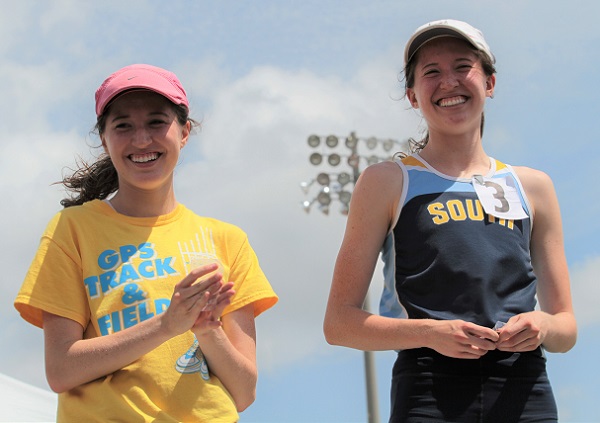
Track Gaining Speed Toward Future with Electronic Starting Devices
By
Steve Vedder
Special for MHSAA.com
May 23, 2023
Aubrey Greenfield thinks it might be the perfect time to reevaluate 130 years of tradition.
For a number of reasons, from technical to personal, the Oxford senior sprinter believes it makes sense for the crack of a starting pistol to be eliminated from high school track meets.
Because track meets would benefit in various ways from lowering costs to easier setup at meets to the human factor of competitors not having to flinch at the crack of a pistol shot, Greenfield believes the sport has a chance to embrace new technology – electronic starting devices (ESD).
In essence, an ESD replaces the starting pistol with a light flash, tone sound or both to begin a race.
"High school sports should put the athlete first," Greenfield said. "We should promote sports, and eliminating starting pistols promotes health in terms of PTSD or trauma for athletes and spectators and that would be good. I would like to think people would say that's a good idea."
In fact, Greenfield would go as far as to say if there was not an implementation of electronic starting devices, many of her teammates would have considered giving up the sport.
"If it's something that helps us compete safely, we're all for it," she said.
Greenfield's opinion apparently is spreading. Michigan High School Athletic Association senior assistant director Cody Inglis said the use of ESD makes it both affordable for meet starters and sensible for athletes and fans to rethink the use of starting pistols. While the MHSAA is not mandating electronic starting devices, it does promote the use of what Inglis calls "emerging technology." He notes that ESD are becoming the norm for organizations such as USA Track & Field, the NCAA and an increasing number of high schools.
 "I think we have to embrace new technology, and we think this will be something that takes hold," Inglis said.
"I think we have to embrace new technology, and we think this will be something that takes hold," Inglis said.
A key part of embracing ESD is the human element. The tragic Oxford High School shooting Nov. 30, 2021, that took the lives of four students while injuring seven others should not be relived even for a fleeting instance at a high school sporting event. Oxford athletic director Tony DeMare said the school began using ESD at every meet, including the MHSAA Lower Peninsula Division 1 Finals last June. He said that decision was embraced by virtually all schools Oxford encountered.
"We were very convinced that the alternative (of ESD) would promote a healthy attitude," DeMare said. "We were overwhelmed with the positive response. If a school was on the fence about it or might not be for it, I think we've started to see the tide turn in favor of people willing to listen and learn about electronic starting devices."
Inglis said the MHSAA is acutely aware of what the crack of a starting pistol can mean to athletes and fans.
"It's unimaginable what Oxford went through, and this is a small way we can help," he said. "We look at a (starting pistol) and think, ‘Could we do something else?’ It's a way of helping to solve a problem."
Over the last several years, the MHSAA has embraced finding an alternative to starting pistols. Inglis noted the discussion started with the cost and diminishing availability of 32-caliber ammunition that meet starters use. A box of ammunition, if it can be found, is around $75 a box.
In addition to cost, there is potential damage from excessive exposure to 150-plus decibels of sound generated by the traditional 32-caliber blanks. Medical studies show damage to ears caused by decibel levels above 120 dB.
The tragedy at Oxford accelerated the conversation.
Inglis said the cost of ESD can be likened to a school sinking money into artificial surfaces at football fields. Yes, there is a great cost at first, but over time money is ultimately saved. An ESD system itself ranges between $200 and $500. Speakers also may need to be purchased, but with ESD starting events like the 800 and 1,600-meter relays positioned near the outside lanes 8, 7, 6 and 5 would result in improved hearing by athletes at the start of a race.
There is one challenge with ESD that track administrators are working to overcome – lighting conditions that lessen the ability to see the ESD’s LED light or strobe when the button is pressed by a starter to begin a race. But that vision difficulty resulting from clear blue skies and backgrounds of setting suns can be substantially improved by incorporating a black background with an ESD – something as simple as a starter holding up black cardboard behind the lighting mechanism at the start of an event.
Inglis said when all factors are considered, the use of ESD makes sense.
 "With the climate we live in nowadays, no lookalike guns is good," he said. "We're not mandating this. But people are saying this is affordable."
"With the climate we live in nowadays, no lookalike guns is good," he said. "We're not mandating this. But people are saying this is affordable."
While switching to ESD would break 130 years of tradition, the timing could be a step forward, said Jeff Hollobaugh, co-author of the book "The Fleet Feet of Spring: Michigan's High School State Championships in Track & Field." He said while no definitive answer is possible, it's likely starting pistols were used at the inaugural state meet at the Jackson Fairgounds in 1895. The meet, which included events like tossing a 16-pound shot put, bike races and a 100-meter sprint, was sponsored by the Michigan Interscholastic Athletic Association (a predecessor to the MHSAA) and comprised mostly of the state's larger schools.
Hollobaugh's sentiments echo what many involved in today's high school track & field believe in terms of making a transition from starting pistols to electronic starting devices.
"It's a change, not necessarily good or bad, just different," he said. "It's not a drastic change, but it will take some getting used to. But it is the future. In the end, we'll all be fine."
DeMare believes the future of high school track will definitely include ESD.
"Our desire is that the practicality and sensibility of this will overcome the alternative," he said. "I think we'll see the automation and electronics taking hold of certain elements in track, and people will embrace it."
PHOTOS (Top) Runners watch official Bertha Smiley as they prepare to begin a race during last season's Lower Peninsula Division 1 Finals at Rockford. (Middle) An electronic starting device provided by VS Athletics was used to start those races. (Below) Smiley sets to begin an event. (Photos provided by David Kuderka/VS Athletics.)

Running Set Life's Stage for Grosse Pointe South's Record-Setting Meier Sisters
By
Tom Markowski
Special for Second Half
July 28, 2022
A decade ago the Meier twins, Haley and Hannah, were instrumental in changing the dynamics of the track & field and cross country programs at Grosse Pointe South.
South had never won an MHSAA Finals team title in either sport before their arrival at the school in 2009. Under longtime coach Steve Zaranek, the Meiers led South to three consecutive MHSAA Lower Peninsula Division 1 track titles (2011-13) and another championship in cross country (2011), while forming half of a national record-setting 3,200-meter relay in the former.
“I've never seen anything like it,” said Zaranek, who will lead the program for a 44th season next spring and recently retired from teaching. “We had all of those athletes. The highlight was the distance (events) with the Meier twins. It was the perfect storm.”
The Meiers attended Duke University for their first two years of college before they transferred to University of Michigan. Their career paths have taken them in different directions, but they remain as close as ever.
Two years ago Haley moved to Adelaide, Australia, with her fiancé Jordy Hewitt, who she met at U-M. Hannah soon will leave Ann Arbor for Charlottesville, Va., where she will begin work as a dietitian within the medical school at the University of Virginia.
Two weeks ago, Haley and Hannah were together in Nashville, Tenn., along with four friends, for Haley's bachelorette celebration. The wedding is scheduled for Oct. 8 on the island of Kauai in Hawaii.
 Haley, who received her bachelor’s degree in education, is in her second year as a middle school teacher in Adelaide, and Hewitt works as a consultant at Price Waterhouse just blocks from St. Mary's College, the all-girls private school where Haley teaches.
Haley, who received her bachelor’s degree in education, is in her second year as a middle school teacher in Adelaide, and Hewitt works as a consultant at Price Waterhouse just blocks from St. Mary's College, the all-girls private school where Haley teaches.
“I always loved spending time with kids,” Haley said when asked why she chose the teaching profession. “When they figure things out, it's so rewarding. It comes with its challenges. I've been practicing my patience daily.”
This past spring Hannah completed her master's degrees in both sports management and public health from U-M, to go with her bachelor’s in kinesiology. Her longterm goal is to work with athletes in their efforts to maintain a healthy lifestyle.
Hannah Meier began researching various types of food and how they affects athletes and their eating habits. For instance, Hannah is a firm believer in a person eating breakfast 30-to-60 minutes after rising to allow for metabolism to kick in properly.
“I was getting injured (so often) between lifting and cross training that I decided to go into public health,” Hannah said. “That's one of the reasons I left Duke. They didn't offer a public health (curriculum).”
The Meiers were highly competitive at both Duke and U-M. At Duke, Haley won the Atlantic Coast Conference title in the 1,500, and for U-M she won the Big Ten Conference title in the indoor mile. In her last season (2019), Hannah won the Big Ten title in the mile with a school-record time of 4:32.46. Both qualified for the NCAA Championships on multiple occasions.
Their college accomplishments stacked on top of significant achievements that helped Grosse Pointe South to those three Finals teams championships.
Hannah continues to own the all-Class/Division Finals records in the 800-meter run (2:06.35, 2013) and 1,600 run (4:39.23, 2013 – also ninth-best all-time nationally at the high school level). She and Haley, along with Kelsie Schwartz and Ersula Farrow, set that national high school record in the 3,200 relay of 8:48.29 in 2012. (Of note, the second-best 3,200 relay time in MHSAA LPD1 Finals history was recorded by Oak Park in 2015, 8:54.29, as Farrow teamed with Jayla Fleming, Lashae Bowens and Dorriann Coleman.)
To show how competitive and talented the twins were, when Hannah set the all-Finals record in the 1,600 in 2013, the previous all-Finals record was the 4:42.60 she had run in 2011. Haley's time of 4:42.43 in 2013 was good enough to top her sister's 2011 record, but not the time Hannah posted that June afternoon – as Haley finished in that race to her sister.
For Zaranek, the post-Meier era has included a team that placed sixth in LP Division 1 in 2014 and another top-15 finisher since, with at least a few Finals qualifiers almost every season.
 “For me and our program,” Zaranek said, “to get to the Regional level and compete, that's the sign of a really good program. I really think the best programs are the ones that allow the students to try different events. We talk about opportunities. We talk about contributing to the team.”
“For me and our program,” Zaranek said, “to get to the Regional level and compete, that's the sign of a really good program. I really think the best programs are the ones that allow the students to try different events. We talk about opportunities. We talk about contributing to the team.”
For the Meiers, they cherish the memories and continue to run but at a much slower pace. In addition to the memories and accomplishments, they say the sport made them better people, more appreciative for what they have and who they are.
“Haley and I ... we have a better perspective on life,” Hannah said. “We are able to handle situations much more calmly.
“And it's all because of Coach Z. We weren't fans of running in middle school. Without running we wouldn't have gone to U-M and graduated. If we hadn't gone to U-M, we wouldn’t have met our significant others.”
(Hewitt, from Australia, was a middle distance runner for U-M when he and Haley met. Hannah's boyfriend, Kevin Haughn, was competing in the pole vault for the Wolverines when they first crossed paths.)
Haley said her life, and Hannah's, are so busy that finding time to run requires a few less hours of sleep at times.
“I enjoy it, but the hardest part is getting up in the morning to do it,” she said. “It's a transition.
“After all these years, it's still practicing good habits. Running has taught us to be resilient, to persevere.”
2021-22 Made in Michigan
July 25: 2005 Miss Basketball DeHaan Cherishing Newest Title: 1st-Time Mom - Read
July 21: Championship Memories Still Resonate with St. Thomas Star Lillard - Read
July 14: Portage Central Champ Rolls to Vanderbilt, Writing Next Chapter in Alabama - Read
July 12: Coaching Couple Passing On Knowledge, Providing Opportunities for Frankfort Wrestlers - Read
June 30: Hrynewich's Star Continuing to Rise with Olympic, Pro Sports Arrivals - Read
PHOTOS (Top) At left, Hannah and Hailey Meier enjoy the moment after helping set a national high school record for Grosse Pointe South in the 3,200 relay in 2012. At top right, Haley and fiancé Jordy Hewitt. At bottom right, Hannah and boyfriend Kevin Haughn. (Middle) The Meier sisters, center, bring their family together in Australia. (Below) Haley, left, and Hannah Meier top the LPD1 1,600 medalist podium in 2013. (MHSAA Finals photos from RunMichigan.com; recent photos courtesy of Hannah and Haley Meier.)

